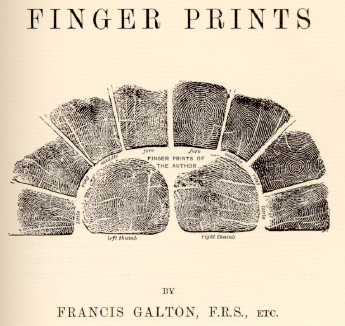 The earliest recorded use of fingerprints dates back thousands of years as a mediocre identification system for the Babylonians and a method for recording business transactions for the Chinese. Only until the 19th century was the science applied to identify criminals.
The earliest recorded use of fingerprints dates back thousands of years as a mediocre identification system for the Babylonians and a method for recording business transactions for the Chinese. Only until the 19th century was the science applied to identify criminals. In 1882, Sir Francis Galton, who studied human characteristics, compiled a database of 8,000 fingerprints for his research into a new system for identification. He published a book called Fingerprints, which became the world's first system for analyzing fingerprints, based on simple patterns in fingerprints that are easily identifiable and unique to every person.
In 1882, Sir Francis Galton, who studied human characteristics, compiled a database of 8,000 fingerprints for his research into a new system for identification. He published a book called Fingerprints, which became the world's first system for analyzing fingerprints, based on simple patterns in fingerprints that are easily identifiable and unique to every person.In 1901, Scotland Yard, quickly followed by other law enforcement agencies around the world, established a Fingerprint Bureau solely for the purpose of identifying criminals by their fingerprints. This event marked the beginning of the use of fingerprints as the perfect unrefutable and unbiased method to pursue and apprehend criminals.
 Before the 1980s, and before Japanese agencies developed an automatic system for fingerprint analysis called AFIS (Automated Fingerprint Identification System), cross-referencing prints lifted at the crime scene with the fingerprints of individuals containing a police record would have to be done manually. This process would take days or more at a time, even with a large workforce, to find a perfect match and a suspect. Understandably, the manpower this method required and the time with which it was done became extremely inconvenient and actually hindered law enforcement agencies. Still, even with their own development of an AFIS system, U.S. law enforcement was still hindered by the lack of coordination between agencies. Local authorities didn't share the same database as state authorities, who still didn't communicate with federal datab ases. Therefore, the AFIS system could only work within a small jurisdiction. That all changed, however, when the IAFIS (Integrated Automated Fingerprint Identification System), was established. This new database allowed the sharing of information between all levels of authorities, making the system faster and more accurate than ever. IAFIS is still in use today, with a databasae containing over 47 million fingerprints.
Before the 1980s, and before Japanese agencies developed an automatic system for fingerprint analysis called AFIS (Automated Fingerprint Identification System), cross-referencing prints lifted at the crime scene with the fingerprints of individuals containing a police record would have to be done manually. This process would take days or more at a time, even with a large workforce, to find a perfect match and a suspect. Understandably, the manpower this method required and the time with which it was done became extremely inconvenient and actually hindered law enforcement agencies. Still, even with their own development of an AFIS system, U.S. law enforcement was still hindered by the lack of coordination between agencies. Local authorities didn't share the same database as state authorities, who still didn't communicate with federal datab ases. Therefore, the AFIS system could only work within a small jurisdiction. That all changed, however, when the IAFIS (Integrated Automated Fingerprint Identification System), was established. This new database allowed the sharing of information between all levels of authorities, making the system faster and more accurate than ever. IAFIS is still in use today, with a databasae containing over 47 million fingerprints.
extremely well done! lots of intricate detail. very insightful!. good use of graphics. :)
ReplyDeleteGreat use of sentence structure.
ReplyDeleteYou have a good balance of text and pictures; good job on this post!
ReplyDelete